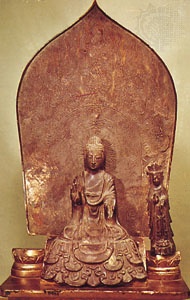Tori style
Japanese sculpture
 in Japanese art, style of sculpture that emerged during the Asuka period (ad 552–645) and lasted into the Nara period (645–794). It was derived from the Chinese Northern Wei style (ad 386–534). It is called Tori (Kuratsukuri Tori) after a sculptor of Chinese descent whose only known piece is a Buddhist triad, which was made in AD 623 as a memorial to Prince Shōtoku. It represents the Buddha Śākyamuni (Shaka) seated on a throne that is flanked on either side by bodhisattvas, with a great mandorla behind.
in Japanese art, style of sculpture that emerged during the Asuka period (ad 552–645) and lasted into the Nara period (645–794). It was derived from the Chinese Northern Wei style (ad 386–534). It is called Tori (Kuratsukuri Tori) after a sculptor of Chinese descent whose only known piece is a Buddhist triad, which was made in AD 623 as a memorial to Prince Shōtoku. It represents the Buddha Śākyamuni (Shaka) seated on a throne that is flanked on either side by bodhisattvas, with a great mandorla behind.Works in true Tori style are very reminiscent of Northern Wei sculpture found at the site of Lung-men in China. Stylistic characteristics include slender, elegant bodies, a strong linear interest in drapery, and a tendency toward squatness in the proportion of the faces and also in the relationship of the body to the feet.
- Table 1 World Production of Centrifugal Sugar
- Table 1 World Production of Major Oilseeds and Products
- Table 1 World Production of Milk
- Table 2 Consumer Prices in OECD Countries
- Table 2 Livestock Inventories and Meat Production in Major Producing Countries
- Table 2 Real Gross Domestic Products of Selected OECD Countries
- Table 2 Selected Indexes of World Agricultural and Food Production
- Table 2 Shipment of Food Aid in Cereals
- Table 2 Standardized Unemployment Rates in Selected Developed Countries
- Table 2 World Cereal Supply and Distribution
- Table 2 World Cocoa Bean Production
- Table 2 World Cotton Production and Consumption
- Table 2 World Green Coffee Production
- Table 2 World Production of Centrifugal Sugar
- Table 2 World Production of Major Oilseeds and Products
- Table 2 World Production of Milk
- Table 3 Consumer Prices in OECD Countries
- Table 3 Real Gross Domestic Products of Selected OECD Countries
- Table 3 Selected Indexes of World Agricultural and Food Production
- Table 3 Shipment of Food Aid in Cereals
- Table 3 Standardized Unemployment Rates in Selected Developed Countries
- Table 3 World Cereal Supply and Distribution
- Table 3 World Cocoa Bean Production
- Table 3 World Cotton Production and Consumption
- Table 3 World Green Coffee Production